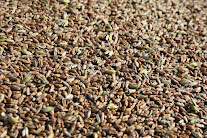Grains are not only a vital source of energy but also a great contributor to dietary protein. If you're looking to increase your protein intake while enjoying the versatility of grains, here's a detailed guide on grains high in protein.
1. Quinoa
Quinoa stands out as a complete protein source, containing all nine essential amino acids.
- Protein Content: About 8 grams per cooked cup.
- Health Benefits: Rich in fiber, iron, and magnesium, making it an excellent choice for vegetarians and vegans.
2. Amaranth
Amaranth is another pseudo-grain that is high in protein and essential nutrients.
- Protein Content: Approximately 9 grams per cooked cup.
- Health Benefits: Contains lysine, a rare amino acid in grains, and is gluten-free.
3. Farro
Farro is an ancient grain with a nutty flavor and chewy texture.
- Protein Content: Around 6 grams per cooked cup.
- Health Benefits: High in magnesium, zinc, and B vitamins, supporting overall health.
4. Millet
Millet is a versatile grain that provides a good amount of protein and essential nutrients.
- Protein Content: About 6 grams per cooked cup.
- Health Benefits: Contains antioxidants and is easy to digest.
5. Teff
Teff is a tiny but nutrient-dense grain originating from Ethiopia.
- Protein Content: Around 10 grams per cooked cup.
- Health Benefits: High in calcium, iron, and resistant starch, aiding in digestion and bone health.
6. Oats
Oats are not only high in protein but also rich in soluble fiber.
- Protein Content: Approximately 5 grams per cooked cup.
- Health Benefits: Helps in lowering cholesterol and maintaining blood sugar levels.
7. Buckwheat
Despite its name, buckwheat is not related to wheat and is gluten-free.
- Protein Content: About 6 grams per cooked cup.
- Health Benefits: Contains rutin, a compound that supports heart health.
8. Bulgur
Bulgur is a quick-cooking whole grain with a decent protein profile.
- Protein Content: Around 5.6 grams per cooked cup.
- Health Benefits: High in fiber, promoting digestive health.
9. Brown Rice
While not as high in protein as some other grains, brown rice is still a nutritious option.
- Protein Content: About 5 grams per cooked cup.
- Health Benefits: Provides magnesium, selenium, and a sustained energy source.
10. Spelt
Spelt is a type of wheat with a higher protein content than regular wheat.
- Protein Content: About 6 grams per cooked cup.
- Health Benefits: Contains B vitamins and supports heart health.
11. Kamut
Kamut, or Khorasan wheat, is a protein-rich ancient grain.
- Protein Content: Approximately 9 grams per cooked cup.
- Health Benefits: High in selenium, which supports antioxidant activity.
12. Sorghum
Sorghum is a versatile grain used in a variety of dishes.
- Protein Content: Around 8 grams per cooked cup.
- Health Benefits: Rich in antioxidants and gluten-free.
13. Rye
Rye is a nutrient-dense grain often used in bread making.
- Protein Content: Around 3.3 grams per cooked cup.
- Health Benefits: Aids in weight management and promotes gut health.
How to Incorporate Protein-Rich Grains
- Breakfast: Use quinoa or oats for protein-packed porridge.
- Salads: Add farro, spelled, or bulgur to salads for a chewy, nutritious addition.
- Side dishes: Serve millet, teff, or sorghum as an alternative to rice or potatoes.
- Baking: Incorporate buckwheat or rice flour into baked goods.
Conclusion
Grains high in protein can be an excellent addition to any diet, whether you're a vegetarian, vegan, or simply looking to diversify your protein sources. By including these grains in your meals, you can enjoy their nutritional benefits while exploring various culinary options.
















0 Comments